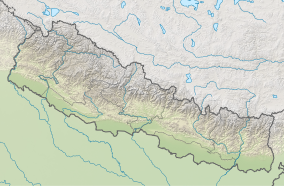|
Shivapuri Nagarjun National Park
Shivapuri Nagarjun National Park is the ninth national park in Nepal and was established in 2002. It is located in the country's mid-hills on the northern fringe of the Kathmandu Valley and named after Shivapuri Peak at 2,732 m (8,963 ft) altitude. It covers an area of 159 km2 (61 sq mi) in the districts of Kathmandu, Nuwakot and Sindhupalchowk, adjoining 23 Village Development Committees.[1] In the west, the protected area extends to the Dhading District.[2] HistoryThe area has always been an important water catchment area, supplying the Kathmandu Valley with several hundred thousand cubic liter of water daily. In 1976, the area was established as a protected watershed and wildlife reserve. In 2002, it was gazetted as Shivapuri National Park, initially covering 144 km2 (56 sq mi).[1] It was extended by the Nagarjun Forest Reserve covering 15 km2 (5.8 sq mi) in 2009.[2] The park includes some historical and religious sites, and a popular hiking route for local people and tourists.[3] ClimateThe park is located in a transition zone between subtropical and temperate climates. The annual precipitation of about 1,400 mm (55 in) falls mostly from May to September, with 80% during the monsoon. Temperatures vary from 2–17 °C (36–63 °F) during the winter season, rising to 19–30 °C (66–86 °F) during the summer season. Vegetation The typical vegetation of the park is middle hill forest from 1,000 to 1,800 m (3,300 to 5,900 ft) of altitude, consisting of:
In higher elevations, a variety of medicinal herbs prosper.[4] Botanists have recorded 129 species of mushrooms and 2,122 floral species, out of which 449 are vascular and 16 are endemic plants.[1][6] Fauna  Since 2002 several surveys have been carried out to determine the faunal diversity of the protected area. In a field study carried out from July 2003 to July 2004, Indian leopard, jungle cat, large Indian civet, golden jackal, Himalayan black bear, yellow-throated marten, small Indian mongoose, Himalayan goral, Indian muntjac, wild boar, rhesus monkey, Hanuman langur, Chinese pangolin, Indian crested porcupine, Royle's pika, Indian hare, orange-bellied Himalayan squirrel, fawn-colored mouse, Hodgsons's brown-toothed shrew and black rat were identified.[7] Clouded leopard, leopard cat, masked palm civet, crab-eating mongoose, Indian pangolin, rhesus macaque and yellow-throated marten, were photographed by camera traps in 2010.[2] In the western part of the park, herpetologists encountered monocled cobra, Himalayan keelback, olive Oriental slender snake, yellow-bellied worm-eating snake, variegated mountain lizard, Oriental garden lizard, many-keeled grass skink, Sikkim skink, black-spined toad, long-legged cricket frog and horned frog in the summer of 2009.[8] Ornithologists recorded 318 species of birds including Eurasian eagle-owl, slender-billed scimitar-babbler, white-gorgeted flycatcher, barred cuckoo-dove and golden-throated barbet.[9] References
Further reading
External links |
||||||||||||||||||||||
Portal di Ensiklopedia Dunia


